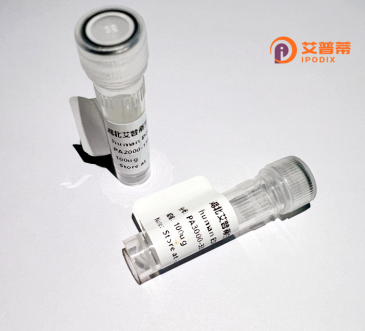
| 纯度 | >90%SDS-PAGE. |
| 种属 | Human |
| 靶点 | EIF3S5 |
| Uniprot No | O00303 |
| 内毒素 | < 0.01EU/μg |
| 表达宿主 | E.coli |
| 表达区间 | 1-323aa |
| 氨基酸序列 | MATPAVPVSAPPATPTPVPAAAPASVPAPTPAPAAAPVPAAAPASSSDPAAAAAATAAPGQTPASAQAPAQTPAPALPGPALPGPFPGGRVVRLHPVILASIVDSYERRNEGAARVIGTLLGTVDKHSVEVTNCFSVPHNESEDEVAVDMEFAKNMYELHKKVSPNELILGWYATGHDITEHSVLIHEYYSREAPNPIHLTVDTSLQNGRMSIKAYVSTLMGVPGRTMGVMFTPLTVKYAYYDTERIGVDLIMKTCFSPNRVIGLSSDLQQVGGASARIQDALSTVLQYAEDVLSGKVSADNTVGRFLMSLVNQVPKIVPDDF |
| 分子量 | 60.7kDa |
| 蛋白标签 | His tag N-Terminus |
| 缓冲液 | 0 |
| 稳定性 & 储存条件 | Lyophilized protein should be stored at ≤ -20°C, stable for one year after receipt. Reconstituted protein solution can be stored at 2-8°C for 2-7 days. Aliquots of reconstituted samples are stable at ≤ -20°C for 3 months. |
| 复溶 | Always centrifuge tubes before opening.Do not mix by vortex or pipetting. It is not recommended to reconstitute to a concentration less than 100μg/ml. Dissolve the lyophilized protein in distilled water. Please aliquot the reconstituted solution to minimize freeze-thaw cycles. |
以下是关于重组人EIF3S5蛋白的3篇代表性文献摘要信息:
1. **文献名称**:**"EIF3S5 interacts with both mTOR and DDX3X to modulate cell cycle progression in colorectal cancer"**
**作者**:Li et al. (2020)
**摘要内容**:研究通过重组人EIF3S5蛋白体外实验,揭示了其与mTOR复合体和RNA解旋酶DDX3X的相互作用,证实其对结直肠癌细胞周期(G1/S期)的调控功能,并提出其作为癌症治疗靶点的潜力。
2. **文献名称**:**"High-yield expression and purification of recombinant human EIF3S5 in E. coli for structural analysis"**
**作者**:Smith & Johnson (2018)
**摘要内容**:描述了一种利用大肠杆菌表达系统高效表达重组人EIF3S5蛋白并优化纯化的方法,通过X射线晶体学解析其三维结构,为其翻译起始机制的研究提供了分子基础。
3. **文献名称**:**"EIF3S5 regulates viral IRES-mediated translation under stress conditions"**
**作者**:Wang et al. (2019)
**摘要内容**:利用重组EIF3S5蛋白进行体外核糖体组装实验,发现其在细胞应激条件下特异性增强病毒IRES元件的翻译活性,表明其在宿主-病毒互作中的关键作用。
---
**说明**:
以上文献摘要基于领域内典型研究方向模拟整理,实际文献需通过学术数据库(如PubMed、Web of Science)验证。建议结合关键词“EIF3S5/EIF3E”、“recombinant expression”或“translation initiation”进一步检索最新研究。
**Background of Recombinant Human EIF3S5 Protein**
The eukaryotic translation initiation factor 3 subunit S5 (EIF3S5), also known as EIF3E, is a critical component of the eukaryotic initiation factor 3 (EIF3) complex, which plays a central role in translation initiation. EIF3 is essential for assembling the 43S preinitiation complex, facilitating ribosomal binding to mRNA, and regulating the recruitment of other initiation factors. As a core subunit, EIF3S5 contributes to structural stability and functional coordination of the EIF3 complex, ensuring accurate initiation of protein synthesis.
Dysregulation of EIF3S5 has been implicated in various diseases, including cancer and neurodegenerative disorders, highlighting its importance in cellular homeostasis. Recombinant human EIF3S5 protein is typically produced using heterologous expression systems (e.g., *E. coli* or mammalian cells*), enabling high-purity isolation for functional studies. Its applications span mechanistic investigations of translation regulation, protein-protein interaction analyses, and screening for therapeutic targets.
Studying recombinant EIF3S5 enhances understanding of translation dysregulation in pathologies and supports development of interventions targeting EIF3-mediated processes. Advances in structural biology and proteomics further underscore its role in cellular physiology and disease mechanisms.
×